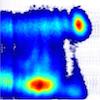Mar 23 2015
In a recent study, "Spatiotemporal isolation of attosecond pulses in the soft X-ray water window " published in Nature Communications by the Attoscience and Ultrafast Optics Group, led by ICREA Professor at ICFO Jens Biegert, the generation of isolated attosecond pulses at the carbon K-edge at 284 eV (4.4 nm), within the water window range, was achieved.
 This image shows an attosecond emission steering with CEP phase. Credit: ICFO
This image shows an attosecond emission steering with CEP phase. Credit: ICFO
Carbon is one of the most abundant elements in the Universe and the building block of life on earth. It is a fundamental element for both organic compounds, such as cells, lipids, carbohydrates, as well as inorganic compounds, such as those used to fabricate carbon nanotubes, graphene, organic electronics and light harvesting devices.
The availability of attosecond duration (1as=10-18s) soft X-ray pulses means that one can follow electronic motion in real time and with element specificity, i.e. at the carbon edge. The time scales permit imaging the triggering events behind bond formation and breaking, the flow of energy in organic solar cells or energy storage devices, or the inner workings of ultrafast magnetic devices or superconductors. Such capability is key for designing new transformational materials with high efficiency or for the development of petahertz electronics.
Until now and after a decade of continuous research and development, attoscience has culminated in the generation of isolated attosecond pulses at photon energies below 120 eV, due to the stringent requirements concerning laser sources. Now, the Attoscience and Ultrafast Optics Group, led by ICREA Professor at ICFO Jens Biegert, has been able to take a considerable step forward by demonstrating, for the first time, the generation of the isolated attosecond pulses at the carbon K-edge at 284 eV (4.4 nm), in the soft X-ray water window. With their experimental setup, they were able to create these ultra-short pulses with pulse duration below 400as and a bandwidth supporting a 30-as pulse duration.
The water window refers to the fact that water is transparent to soft X-rays in the range between 530 eV/2.34 nm (K-absorption edge of oxygen) and 280 eV /4.4nm (K-absorption edge of carbon), while other elements are absorbing. Aside from the incredible attosecond time resolution, the table top realization at ICFO would permit soft X-ray microscopy on the atomic level of carbon containing compounds inside living compounds and specimens.
Source: http://www.icfo.eu/